Coordinators:
Kim Seog-min (South Korea)
Hideo Shimura (Japan)
Peter Adriaens (Belgium)
Mars Muusse (Netherlands)
slaty rings
slaty PDFs
slaty 1cy August
slaty 1cy September
slaty 1cy October
slaty 1cy November
slaty 1cy December
slaty 2cy January
slaty 2cy February
slaty 2cy March
slaty 2cy April
slaty 2cy May
slaty 2cy June
slaty 2cy July
slaty 2cy August
slaty 2cy September
slaty 2cy October
slaty 2cy November
slaty 2cy December
slaty 3cy January
slaty 3cy February
slaty 3cy March
slaty 3cy April
slaty 3cy May
slaty 3cy June
slaty 3cy July
slaty 3cy August
slaty 3cy September
slaty 3cy October
slaty 3cy November
slaty 3cy December
slaty sub-ad January
slaty sub-ad February
slaty sub-ad March
slaty sub-ad April
slaty sub-ad May
slaty sub-ad June
slaty sub-ad July
slaty sub-ad August
slaty sub-ad September
slaty sub-ad October
slaty sub-ad November
slaty sub-ad December
slaty ad January
slaty ad February
slaty ad March
slaty ad April
slaty ad May
slaty ad June
slaty ad July
slaty ad August
slaty ad September
slaty ad October
slaty ad November
slaty ad December
|
Slaty-backed Gull (schistisagus) 3rd cycle / 4CY April
3rd generation flight feathers. In general these are adult-like birds, with obvious immature markings. Ageing can be difficult at this age, especially between 3rd cycle and 4th cycle birds. Immature birds with extensive black in the tail and extensive brown wing-covert patches should normally also be in 3rd cycle. However, advanced 3rd cycle and retarded 4th cycle birds are extremely similar, and such birds are probably best labelled "sub-adult".
= = = = = = = = = = = = = = = = = = = = = = = = = = = = = = = = = = = = = = = = = = = = = = = = =
Below you will find a description of Chapter 30. SLATY-BACKED GULL, as published in one of the best Gull publication: "Gulls of the Americas" by Steve Howell & Jon Dunn.
"we" in the text below refers to the original authors. If any errors occur in this text, please let me know and mail to marsmuusseatgmaildotcom.
= = = = = = = = = = = = = = = = = = = = = = = = = = = = = = = = = = = = = = = = = = = = = = = = =
BACK TO PART 3: FIELD IDENTIFICATION, SIMILAR SPECIES - FIRST CYCLE
BELOW: FIELD IDENTIFICATION, SIMILAR SPECIES - SECOND CYCLE
Note overall size and structure, bill size and shape, two-tone pattern of outer primaries, slaty gray incoming feathers on back.
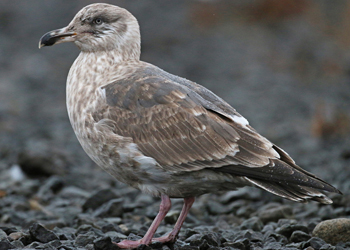 |
 |
| Slaty-backed Gull (schistisagus) 2nd cycle (2CY), December 26 2013, Cape Nosappu, Hokkaido, Japan. Picture: Ian Davies. Pale iris in this bird, much dark in tail. Strong pink, short-looking legs. |
Slaty-backed Gull (schistisagus) 2nd cycle, December 25 2013, Shibetsu Harbor, Shibetsu, Hokkaido, Japan. Picture: Ian Davies. Upperpart grey tone shining through as the new feathers grow in. Much dark in tail. Note overall very simple pattern on wing-coverts and tertials, lacking any notching (no post-stamp edges). |
VEGA GULL and AMERICAN HERRING GULL often more boldly barred on upperparts in fresh B2 with incoming medium (Vega) to pale (American Herring) gray on upperparts; inner primaries contrast more abruptly with blacker outer primaries, which lack strong two-tone pattern of Slaty-backed.
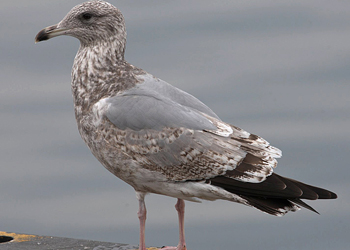 |
 |
 |
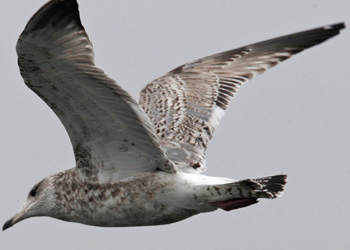 |
| above: 4x Vega Gull (vegae) 2nd cycle, December 27 2009 - January 04 2010, Choshi, Japan (Chris Gibbins). 2nd gen flight feathers, sometimes with faint mirror on P10. Often thin vermiculation at the tops of innerwebs of P2-P4, similar to Herring Gull. Very pale on rump and proximal half of rectrices. Markings on undertail coverts widely spaced. |
 |
 |
American Herring Gull 2nd cycle, December 12 2013, Tompkins Co, NY (Kevin McGowan). 2nd gen flight feathers, and most coverts also 2nd gen. Still no grey scaps. Limited partial autumn moult, 3rd gen coverts much 2nd gen-like patterned. |
American Herring Gull (smithsonianus) 2nd cycle, December 08 2012, Lake County, IL (Amar Ayyash). Classic 2nd cycle plumage with pale panel on inner primaries, and mostly dark outer primaries. |
THAYER’S GULL paler overall with incoming back feathers pale gray. Wing and tail patterns similar to Slaty-backed but tail less blackish, and dark/light contrast on outer primaries averages stronger at shaft.
 |
 |
Thayer's Gull 2nd cycle, February 24 2009, Vancouver Island, BC (Guy Monty). Delicately built. 2nd generation primaries, pink base of bill and single grey-based feathers in scapular region. |
Thayer's Gull 2nd cycle, December 08 2012, Lake County, IL (Amar Ayyash). 2nd gen flight feathers, P10 with 'ghost mirror'. Fine vermiculation on the tips of P1-P4. Scapular region almost completely grey, but still intermixed with faint grown feathers. Tail almost completely dark and bill predominantly dark. |
WESTERN GULL has more-uniform and darker upperwings with poorly contrasting pale inner primaries, lacks two-tone outer primaries of Slaty-backed.
 |
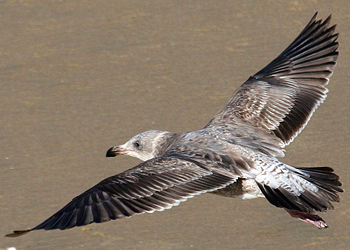 |
Western Gull occidentalis 2nd cycle, November 1985, California (Alex Abela). Note pattern on 2nd gen secondaries. Partial autumn moult included some coverts: GC2-3, MC3, LLC4-7 and few LC, which look fresh and are plain grey. |
Western Gull occidentalis 2nd cycle, February 24 2007, Orange Co (John Avise). Broad-winged. All flight feathers 2nd generation. |
HYBRID GLAUCOUS-WINGED GULL X AMERICAN HERRING GULL has blackish to dark brown wingtips and tail, incoming pale gray on upperparts. Field characters need study.
HYBRID GLAUCOUS-WINGED GULL X WESTERN GULL has more-uniform and often darker upperwing coverts, but primary pattern might approach Slaty-backed; incoming gray on upperparts paler (Kodak 6-8), wings and tail blackish to dark brown.
 |
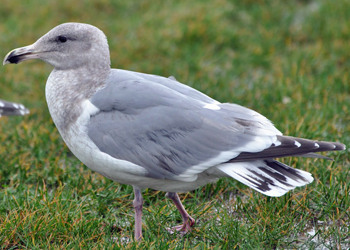 |
Olympic Gull (occidentalis x glaucescens) 2nd cycle, January 02 2012, Gray's Harbor, WA (Amar Ayyash). Bulky bird. Mottled texture as in Glaucous-winged, medium grey tail and primaries as in Western, pale grey upperparts intermediate. |
Olympic Gull (occidentalis x glaucescens) 3rd cycle, January 02 2012, Gray's Harbor, WA (Amar Ayyash). Bulky bird. Mottled texture as in Glaucous-winged, dark grey in tail and primaries indicate Western influence; pale grey upperparts intermediate. |
Third Cycle.
Differences from Vega Gull, Western Gull, and hybrids much as adult cycle (which see); note wingtip pattern, bill size and shape, tone of upperparts, leg color.
|
Your pictures here? |
 Slaty-backed Gull (schistisagus) / オオセグロカモメ / 큰재갈매기
Slaty-backed Gull (schistisagus) / オオセグロカモメ / 큰재갈매기












